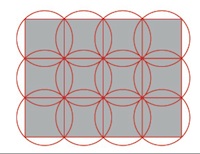The print tech that's turning saving pixels into saving millions

While the economic slump continues to bite around the world, companies are looking at the what they can do without to make savings in the business.
One Israeli company is making a virtue of doing without when it comes to printing by developing a newly patented technology that does away with spare pixels, saving ink - and money - in the process.
Shaving off a little bit of printer toner on each pixel in a printed document may seem like small beer when it comes to a business's bottom line, but Spain's Seguridad Social (the Spanish government's social security agency) has saved about $1.2m annually over the past few years using a system developed by Israeli company Preton.

Preton's Pixel Optimizer technology – which received its US patent just this week – is already used by dozens of other government organisations, as well as businesses, in Europe and the US. While the algorithms that go into the system are complicated, the idea is very simple, according to Preton CEO Ori Eizenberg.
"Computer pixels are square, but printers can't read squares, just circles. One of the tasks of printer drivers is to convert square pixels into circles. But during the print process, the circles overlap, trying to 'recreate' the squares on the screen, and creating unnecessary coverage and overuse of ink and toner – by far the most expensive part of a printed document," said Eizenberg, who estimates that toner and ink account for 50 to 60 percent of a printed document's cost. "Preton's proprietary algorithms determine which pixels can be removed, and deletes them."
The result, said the Preton CEO, is that ink and toner bleed into the spaces where the overlapping pixels have been removed, ensuring a smooth look to the final printed document – while saving on toner and ink use, one pixel at a time.
Preton's product includes software that lets administrators control the printing process from A to Z, with reports, rules, and an audit trail. "Our software automatically identifies all printers on a network," said Eizenberg, "including printers whose existence have long been forgotten, but are still active. Every organsation that uses our system finds these 'phantom' printers on their networks, and they are able to find out where they are and what they are used for, enabling them to get rid of printers that aren't being fully utilised."
Eizenberg started Preton started about 10 years ago, after working with several companies on cutting printing costs. In order to ensure that the system could be used in a wide variety of business settings, Eizenberg reached out to "companies from 20 different verticals", and discovered that there was a great deal of "waste printing" going on - both in the overlaid ink and toner the Preton system manages, and in the number of extra pages and unnecessary documents being produced.
While rumours of the advent of the paperless office abound, the popularity of printing shows no signs of diminishing any time soon; Preton now lists the likes of Samsung, Japan's Tokai, the State of Ohio, UK police forces, government offices in Hong Kong, the Prime Minister of Israel's Office, the Israel Electric Company, and many banks in Europe among its customers.
Now, having been granted a patent for Pixel Optimizer, Preton is moving onto areas beyond printing, Eizenberg said, expanding its product offerings to document compliance and other areas.